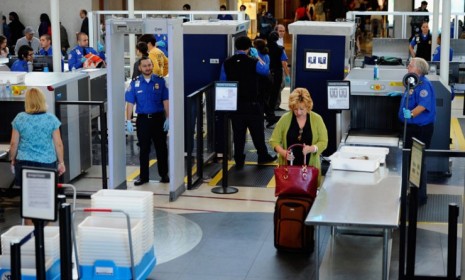Are airport X-ray machines ruining Kindles?
E-readers, beware! Some Amazon customers report that after going through airport security, their devices' e-ink displays became unreadable messes

Traveling with tablets and e-readers has certainly made passing the long hours on a cramped flight easier for countless passengers. But those traveling with Amazon Kindles should be cautious. Multiple users have reported recently that their Kindle screens were mysteriously and permanently damaged by airport X-ray machines. Here's what you should know:
What happened?
Travelers say that after their e-readers went through X-ray machines, the e-ink displays were permanently damaged. One user said his screen froze after going through security. Another noted that the screen on her son's Kindle was so badly effected that it "looked like a magic eye etch-a-sketch," and that "the screen [was] burned so badly that even in the off position you see all of the lines and squiggles and letters."
The Week
Escape your echo chamber. Get the facts behind the news, plus analysis from multiple perspectives.

Sign up for The Week's Free Newsletters
From our morning news briefing to a weekly Good News Newsletter, get the best of The Week delivered directly to your inbox.
From our morning news briefing to a weekly Good News Newsletter, get the best of The Week delivered directly to your inbox.
What is Amazon's defense?
The company says X-ray machines should not harm Kindles. "Exposing your Kindle to an X-ray machine, such as those used by airport security, should not cause any problems," a spokesperson says. "Many Kindle users travel by air, and their Kindles are screened by airport security every day without issue." Customers who have had their Kindle ruined after going through airport security say Amazon has willingly replaced the devices.
How do e-ink screens work?
They use thousands of tiny capsules filled with magnetic white and black particles. Small amounts of electricity applied to the capsules move them to create new pages. The particles remain in place until more electricity is applied. This allows e-ink screens to have excellent battery life, and to be easier on the eyes than the more dynamic, flickering color LCD screens found on the iPad and the new Kindle Fire.
A free daily email with the biggest news stories of the day – and the best features from TheWeek.com
So why might scanners be frying these devices?
Professor Daping Chu, an expert on electronic ink and head of the University of Cambridge Center for Advanced Photonics, has some ideas. "You can get a buildup of static inside these machines, caused by the rubber belt" of the X-ray machine rubbing up against the Kindle, he says. "It's conceivable that [the charge] could damage the screen" — especially if it's "100 volts or more."
Is this happening to other e-readers?
According to The Consumerist, there have been no reports of other e-readers, like the Barnes & Noble Nook, experiencing such problems. Like the Kindle, the Nook has an e-ink display. Most tablets, like the iPad and new Kindle Fire, have an LCD screen.
What can Kindle owners do to travel safely?
It's possible that the problem arises when users pull their Kindles out of their bags, leaving them directly exposed to the damaging static electricity. "I would recommend not taking [your Kindle] out of your bag, just in case," says Jesus Diaz at Gizmodo.
Sources: Consumerist, Daily Mail, Gizmodo, Telegraph
-
 A running list of the US government figures Donald Trump has pardoned
A running list of the US government figures Donald Trump has pardonedin depth Clearing the slate for his favorite elected officials
-
 Ski town strikers fight rising cost of living
Ski town strikers fight rising cost of livingThe Explainer Telluride is the latest ski resort experiencing an instructor strike
-
 ‘Space is one of the few areas of bipartisan agreement in Washington’
‘Space is one of the few areas of bipartisan agreement in Washington’Instant Opinion Opinion, comment and editorials of the day